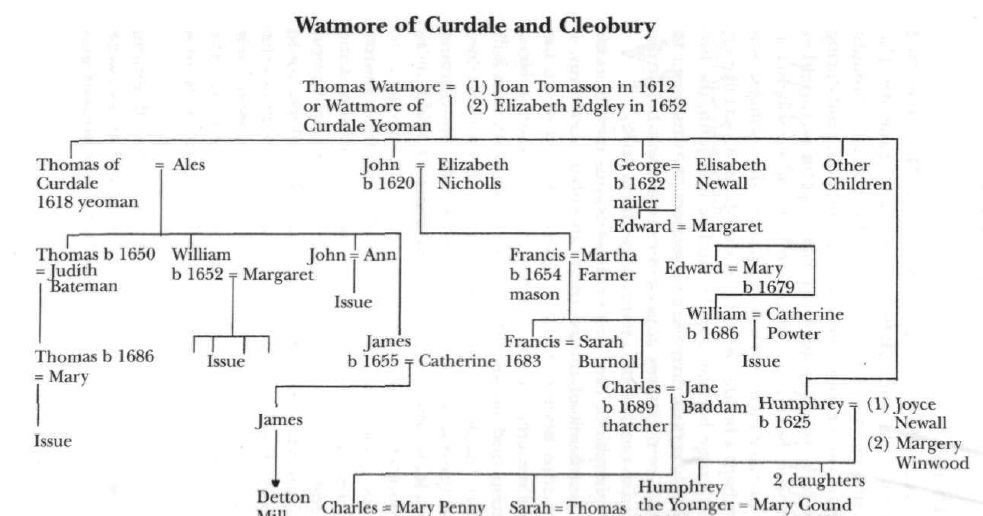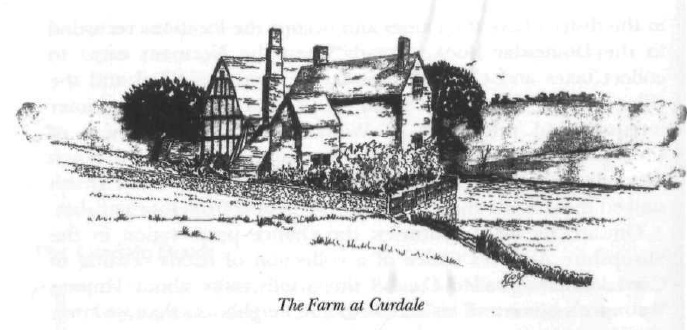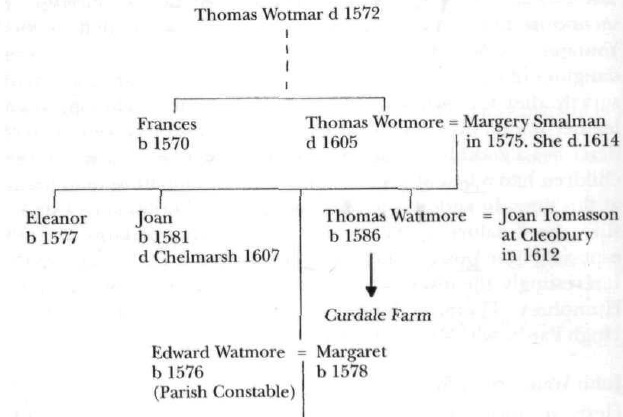
Baptism record for Humphrey Wattmer in Cleobury Mortimer:
"Humfrey the son of Tomas Wattmor & Johan his wief was baptised the xxxith day of August 1625"
FAMILY GROUP RECORD OF
HUMPHREY WATTMER AND
JOYSE NEWALL
Humphrey Wattmer was christened 31 August 1626 in Cleobury
Mortimer, the son of Thomas and Johan (Joan) Watmer.

Humphrey married Joyse Newall in Bewdley, Worcestershire, a town
about eight miles east of Cleobury Mortimer. There is no
christening record for Joyse in Bewdley, but there are christening
records for both Joyse and her sister Elizabeth in Cleobury
Mortimer. Joyse was christened 21 December 1623 in Cleobury
Mortimer, the daughter of Thomas Newall and Margery Cooke.
"The marriages of three of Thomas of Curdale's sons are on record: George and Humphrey married two sisters in Bewdley, Elizabeth and Joyce Newall; John married Elizabeth Nicholls in Cleobury parish church, a kinswoman, no doubt, of Thomas Nicholls, third husband of Joyce Watmore, who married into the Chorley family. Thomas was already married to Alice, perhaps in a distant parish, for the ceremony is not recorded in the few pages of the Cleobury register for the period. The resulting four families carried on the long line of Cleobury Watmores through many vicissitudes until the end of the next century." (Whatmore Panorama)
Humphrey worked as a carter. "Thomas, the eldest son, had stayed on at the farm at Curdale while the others sought out crafts whereby to make their own way. Humphrey, the youngest, was a carter and perhaps a builder, serving on the Manor Court like his eldest brother. George became a nailer, and he and John, the two who most probably served their King as soldiers at arms, seem to have spent much of their lives as poor men; each was below the income required to contribute to the Hearth Tax in 1672." (Whatmore Panorama)
Records of the vicar give
information about Humphrey: "A revealing glimpse of the
lives of these young men is to be found in the notebook of
the methodical Robert Goodwin, a puritan divine who became
vicar in 1656, conformed at the Restoration and remained in
his benefice until his death in 1691. A man of system and
order, the Reverend Goodwin carefully recorded his household
purchases, his income from tithes and teaching, and a great
many building and farm expenses. Thomas Watmore, the eldest
son, worked for the vicar in addition to assisting his
father at Curdale. Early in these developments, around 1677,
the Reverend Goodwin was much occupied with his own
construction work where Humphrey Watmore assisted him with
the transport and delivery of materials. The vicar's
accounts reveal purchases of timber, doors, hinges, loads of
lime, spikes, glazing and thatching; altogether a
substantial job which may have been work on the new
vicarage, which dates from this period. It was in February
when the tracks were deep in mud that Humphrey used the
vicar's wain to fetch several loads of timber, a task well
worth the 3s 6d he was paid for each load. Payments were
made also to the Watmores for nails, where George was
probably the supplier and Humphrey helped with the
transaction.
Humphrey, the youngest son of Thomas One, who
had assisted the Reverend Goodwin with building work, lived
in a small house with one hearth and served on the Manor
Court with his brothers. As a young man he went courting in
Bewdley with his brother George and they married two sisters
there, Joyce and Elizabeth Newall. His second wife, Margery
Winwood, was also related to this tight-knit clan, a
kinswoman of John Winwood, husband of his sister Ales. Two
daughters were born first to Humphrey and Joyce, Hester who
was to marry John Munday in 1673, and Joyce who wed John
Whistons a year later. With the high mortality rate, second
and even third marriages were commonplace and it would
appear that both Hester and Joyce married widowers. John
Munday already had seven children by his first wife, and
John Whistons, a forgeman, wed Joyce immediately after the
death of his wife Elizabeth. He himself was dead within the
year leaving his widow alone to bear their child."
(Whatmore Panorama)
Joyse died and was buried 22 November 1684 in Cleobury Mortimer.
Humphrey then married Margery Winwood 7 February 1684/5 in
Cleobury Mortimer. Margery died 5 December 1690 in Cleobury
Mortimer.

Humphrey died and was buried 3 January 1709 in Cleobury Mortimer.
Humphrey and Joyse had the following children:
1. Hester, christened 22 April 1650 in Cleobury Mortimer;
married John Munday 22 May 1673 in Cleobury Mortimer.
*2. Joyce, christened 8 December 1651 in Cleobury
Mortimer; married 1) John Whistons 30 January 1674 in Cleobury
Mortimer, 2) Edward Vahon 14 December 1679 in Cleobury Mortimer;
buried 18 December 1692 in Cleobury Mortimer.

3. Humphrey, christened 17 March 1654 in Cleobury
Mortimer; married Mary Cound May 1683 in Cleobury Mortimer. "Following
tradition, Humphrey named his only son Humphrey, and he married
Mary Cound in 1683. The younger Humphrey died before his father
in 1697 and Mary was required to prepare an inventory of his
possessions - the only surviving probate record of the Cleobury
line. His goods were valued at £18.19.6d and included £1 for
brass and pewter and £1.2.0d for working tools (though it is
frustrating not to be told what tools they were). It is always a
matter for remark, the value of beds and bedding our ancestors
left behind them. Bedding is a major item in most inventories
and, in the younger Humphrey's case, a generous valuation of £5
was allowed for it. In earlier years families were always
careful to distinguish between the superior feather bed, soft
and often imported, and the lumpy plebian flock bed for children
and servants. Like most villagers of his time Humphrey never
strayed far from the land and left two pigs and "tilling on the
ground, hay and other things forgotten", valued at £4.2.6d."
(Whatmore Panorama)


Thomas was a
yeoman farmer of Curdall or Curdale. "This is a
tale of one house, the home of three generations of
Watmores, owned by a succession of noble landlords...The
house is called Curdale Farm today, lying on the
westward road out of Cleobury Mortimer, a half-timbered
building which has stood for more than four hundred
years. The parish register tells us that it was to this
house in 1612 that Thomas Watmore, a yeoman, possibly
from Neenton, brought his new wife Joan Tomasson and
founded a Cleobury family which continues in Shropshire
today. Their descendants in Cleobury, shopkeepers and
smallholders, are plain folk like their ancestors. But
the farm at Curdale was once connected with more famous
families, the Devereux, who hold the Viscountcy of
Hereford, and the Knightleys of Fawsley, who worked with
Pym and Hampden for the cause of Parliament against the
King." (Whatmore Panorama)

In Whatmore Panorama
the farmhouse at Curdale is described: "The farmhouse rises from
a slope in the hillside as if it grew there, so close
that the entrance is by the way of a gallery from which
the house wall falls sheer to the pond below. Though
inconspicuous, it was once a fine place, with an oak
staircase and, in the living room behind the modern
hearth, a larger chimney corner. The frame timbers are
pitted with age but the house probably stands on even
older foundations, for many of the farms in the district
have the names and occupy the locations recorded in the
Domesday Book. Already when the Normans came to collect taxes and clear the woods, the
land was tilled and the villages were established. Later
still, Curdale was Mortimer territory and the home of
William de Curdewall, vicar of Cleobury from 1349 to
1362. His ministrations were much needed in the year of
his appointment when the Black Death stalked these lands
and carried off 158 people from four parishes. Onward by
three centuries, the chance preservation in the
Shropshire Archives Office of a collection of deeds
relating to Curdale (it was called Curdall then) tells
more about Thomas Watmore's home and his landlords and
neighbours than we know of most of his contemporaries.
Because of these deeds, it is the landlords who occupy
the centre of the stage, though the dramas and high
policies in which they engaged were no doubt the subject
of fascinated gossip in the Curdale community."
(Whatmore Panorama)







